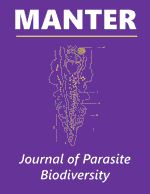Parasitology, Harold W. Manter Laboratory of
Date of this Version
9-30-2016
Document Type
Article
Citation
MANTER: Journal of Parasite Biodiversity (ISSN 2470-8224)
Occasional Papers, Number 6, September 30, 2016.
http://doi.org/10.13014/K2BG2KWF.
This paper was part of a symposium on mammal parasite biodiversity, “CLM20—Zoonosis y mamíferos Neotropicales” [Zoonoses and Neotropical Mammals], presented at III Congreso Latinoamericano de Mastozoología, Bogotá D.C., Colombia, 1 al 5 de diciembre del 2015.
Abstract
Emerging infectious diseases are a growing threat to human health and a great challenge for global medical attention systems. Governmental agencies in tropical regions with abundant zoonotic pathogens should implement an active vigilance/monitoring model in bat reservoir populations because of their species richness, abundance and dispersal capabilities. Chiropterans represent approximately 20% of all mammal species, the second largest order in terms of number of species after rodents. Importantly, bats constitute natural reservoirs for potential infection of humans of several infectious disease agents such as Coronavirus, Filovirus, Lyssavirus, Paramyxovirus, and Flavivirus. Local disease outbreaks caused by new pathogens can expand globally as a result of human intrusion on wildlife ecosystems and subsequent dispersion of pathogens facilitated by international travel—for example, what happened in 2003 during the severe acute respiratory syndrome pandemic (SARS). At this time, it is not possible to predict which pathogen will cross the species barrier in the future. Nonetheless, a better understanding of a holistic transmission process could help the design of strategies to prevent and control of future pandemics. In this work, we present a summary of the potential societal (economic and epidemiological) effect of disease outbreaks of virus families associated with bats, and the preventive and control measures that could be anticipated.


Comments
Copyright © 2016, Calderon, Guzman, Salazar-Bravo, Figueiredo, Mattar, and Arrieta. Open access license, CC BY-NC-SA 4.0 International.
The archive of record for nomenclatural acts in this journal is the Internet Archive.